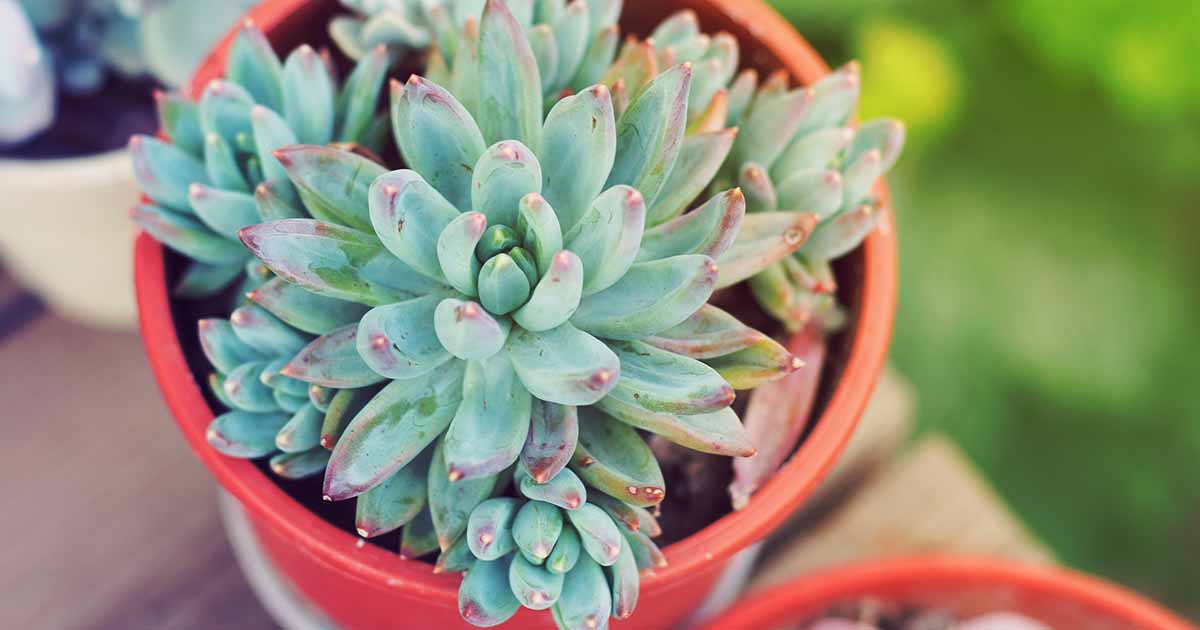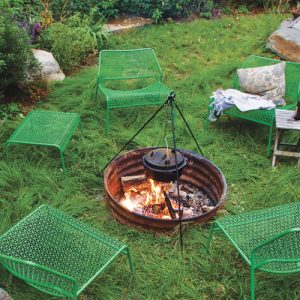
x Pachyveria
With chunky or faceted leaves, pachyverias are succulents with fascinating visual textures.
They can be grown as beautiful windowsill houseplants, or can even serve as xeric ground covers in the right locations.
Whatever your plans for this lovely plant, if you’re eager to grow one of your own, you’ll be pleased to know that upkeep is a breeze!

We link to vendors to help you find relevant products. If you buy from one of our links, we may earn a commission.
Whether you’re cultivating these succulents indoors or out, in this article we’ll cover all you’ll need to know to keep your pachyveria flourishing.
Ready for a peek at what we’ll cover?
Whether their leaves are chunky or angular, pachyverias have growing requirements that are similar to the succulents typically cultivated as houseplants.
If you’re looking for basic care recommendations for fleshy plants, you might also want to read our complete guide to growing and caring for succulents.
What Are Pachyverias?
Pachyverias are evergreen succulents that form open or compact rosette shapes, depending on the type. These plants produce offsets which give them a spreading, clumping growth habit.
As intergeneric hybrids, different succulent species are involved in creating these crosses, so there’s variation in leaf type, foliage color, and plant height and spread.

In general, pachyveria rosettes tend to reach four to six inches tall and wide, with the spread of the plant depending on the number of offsets.
The leaves may be oval, wedge shaped, narrow, or spoon shaped. Some have leaves with pointed tips, while others have blunt edges. The leaves of some cultivars have intriguing geometrical angles, and others are rounded and quite chunky.
Foliage is usually blue or blueish green, but can have tinges of red, purple, pink, or orange.
The foliage is covered with a thick natural coating called epicuticular wax or farina, which is what gives pachyverias their blue glow.

It’s not unusual for pachyverias to produce flowers, even indoors, if they are grown in sufficient light.
Their flowers are pendulous and bell shaped with five petals, and are usually pink with yellow interiors, held on arching flower stems.
Cultivation and History
As I mentioned earlier, pachyverias are intergeneric crosses between members of the Pachyphytum genus and species in the Echeveria genus.
Such a cross would be similar to hybridzing a mountain lion and a house cat, if such a thing were possible. It’s not – but many plants aren’t as choosy when it comes to reproduction!

As hybrids of Echeveria and Pachyphytum species, these members of the Crassulaceae or stonecrop family are related to numerous succulent relatives, such as hens and chicks, kalanchoe, crassula, and sedum.
Pachyverias have been in cultivation perhaps as far back as the 1930s, or at least since before 1960, when x Pachyveria albo-mucronata was described in “A Handbook of Succulent Plants” by Hermann Jacobsen, available via Amazon.

Pachyverias make great houseplants for indoor gardeners with sunny windowsills or grow lights, and they can also be used outdoors year round in drought-tolerant, xeriscaped yards in USDA Hardiness Zones 10 to 11.
Pachyveria Propagation
Since pachyverias are hybrid crosses, they may not grow true from seed.
However, if you want to propagate new pachyverias, you still have options!
From Leaf Cuttings
To propagate these succulents from leaf cuttings, remove one or more healthy lower leaves, making sure the break is clean, and made where it joins the stem of the plant and not in the middle of the leaf.

You’ll also want to choose a leaf to remove that doesn’t change the beautiful symmetry of the rosette too much.
To decide which leaf to remove, I hold my thumb over it first, so I can easily imagine how the pachyveria is going to look without that leaf.
Once you’ve removed one or more leaves, allow them to callus off, which can take five days or more, depending on your environment.
To do this, put the leaves on a plate or in a shallow cardboard box and place them in a dry location out of direct sunlight. Just don’t put them so far out of your field of view that you forget about them!
And if you’re propagating more than one type of succulent at a time, be sure to label them so that you can keep track of what’s what.
With an ever expanding houseplant collection, I’d be lost without my metal plant labels to keep everything identified.
Pick up a pack of 50 metal plant labels from the Tinsky Store via Amazon.
Within a few days, the cut ends of the leaves will begin to callus and may even start producing roots.
When the callus has formed, place the leaves horizontally, with callus (and roots, if there are any) facing down on a pot or tray filled with damp succulent growing medium.
A two- or two-and-a-half-inch pot works well for a single leaf.

If you’re rooting several leaves, you can use a larger pot or a tray, spacing the leaves two inches apart to allow room for them to grow.
Use a mister to keep the surface of the growing medium moist and keep the pots in indirect, bright light.
Within a few weeks, roots will anchor themselves in the potting soil and as the leaf cuttings start to wither, new plantlets will grow from the callus.
When a plantlet has several leaves, you can transplant it into its own two-inch pot if it’s not already growing in one.
Learn more about propagating succulents from leaf cuttings in our guide.
From Stem Cuttings
If you want to propagate a new specimen from a mature pachyveria that has multiple rosettes, you can also take a stem cutting.
With this method, instead of propagating a new plantlet from a leaf, you’ll re-root one of those rosettes.

Use a pair of sharp, sterilized garden snips to take a three- to six-inch long cutting.
Trim the cutting so there’s just an inch or so of stem below the rosette.
Place the cutting on a plate or in a shallow box in a location with plenty of air flow and away from direct sunlight to allow the wound at the cut end to callus over. Place the cutting either on its side or rosette down so that the wound is exposed to the air.
A callus should form within four to seven days, and sometimes roots will start to grow along the stem during this time.
When a callus has formed over the wound, transplant the cutting into a pot, but don’t water right away.
You’ll learn more about transplanting shortly, so keep reading!
From Offsets
Pachyverias may also produce offsets that can be separated from the mother plant and repotted as separate specimens.

Gently remove the succulent from its pot, separate the offsets using a sharp, sterilized blade, and let both mother pachyveria and offsets callus over for four to seven days before repotting.
Learn more about propagating succulent offsets in our guide.
From Transplants
Is your pachyveria too snug in its pot? Or are you ready to pot up a new specimen propagated from a leaf cutting, stem cutting, or an offset?
Did you purchase a bare root pachyveria or one that is in the wrong type of growing medium?
If you answered yes to any of those questions, you’ll want to transplant the succulent!
You’ll need a container that’s just one size larger than the current pot (if the specimen is potted), and some growing medium.
I like to make a mix using 50 percent commercial cactus and succulent growing medium and 50 percent grit, such as pumice or lava rocks.
Rosy Soil Cactus and Succulent Mix is a great peat-free commercial blend to have on hand for succulent plants.
Rosy Soil Cactus and Succulent Mix
Pick up a four-quart bag from Rosy Soil via Walmart.
And if you don’t already have a supply of horticultural lava rocks on hand (who knows, you might!), you can pick up a one-quart bag of 1/4 inch lava rocks from Bonsai Boy.
Wondering what size pot to use? Here are some recommendations depending on the size of the succulent:
- For plantlets propagated from leaf cuttings, a two- or 2.5-inch pot will do.
- For offsets or specimens propagated from stem cuttings, choose a two- to four-inch pot, depending on the size of the rosette.
- Bare root plants and those that need fresh growing medium should be potted in containers just big enough to contain the root ball.
- If you are repotting an established specimen that has outgrown its container, choose a pot just one size larger than the current pot.
Whatever container you choose, make sure there are drainage holes in the bottom of the pot.
Are you potting stem cuttings, leaf cuttings, or offsets?
If so, fill the pot with growing medium, leaving an inch of room between the top of the medium and the rim of the pot.
Poke a hole in the medium and insert the stem or base of the offset or plantlet.
If you are transplanting an established specimen or a bare root pachyveria, place just a small layer of growing medium at the bottom of the new pot. If the new substrate is the same type you used previously, tease out the edge of the root ball.
In the case that you are using a different type of potting medium, remove as much of the old soil around the roots as possible.
Next, insert the root ball and backfill with your chosen potting medium.
You can use a chop stick or pencil to nudge the growing medium into and around the root ball of bare root plants.
Make sure the foliage is above the surface of the medium, don’t cover it with potting soil.
Also, to keep the pachyveria’s foliage from direct contact with the growing medium, consider adding a thin layer of lava rocks as a top dressing, which will also make the plant look even more attractive.
After transplanting, don’t water the pachyveria right away – instead, wait a week, then after it has acclimated to its new pot, you can give it some water.
How to Grow Pachyverias
There will be some variation in the growing needs of pachyverias depending on the particular cross – particularly concerning sun exposure. So be sure to ask the seller if there’s anything unusual about your particular cultivar’s requirements.
Most pachyverias you’ll come across have similar needs, though.
When you bring a houseplant home for the first time or before you purchase it, inspect the foliage as well as the root ball for signs of diseases or pests. You’ll learn what to look for later in the article, so keep reading!

Provide at least six hours of direct sunlight, with some shade during the hottest part of the day.
If the pachyveria is living indoors for part or all of the year, you will likely need to supplement it with a grow light unless you’ve situated it in a bright sunroom or a greenhouse.
As for water, allow the growing medium of these drought tolerant succulents to dry out completely between waterings.
However, do try to keep your watering routine fairly regular or the plants may become stressed and look less than stellar.
In winter, when days are shorter and the sun is less intense, pachyverias will need to be watered less frequently.
The bottom watering method works well for these succulents.

Choosing a good growing medium is just as important as getting watering and light exposure right.
The growing medium needs to have excellent drainage, and a slightly acidic pH of between 6.1 to 6.5.
Preferably, the medium should have 50 to 70 percent of gritty, mineral content from small lava rocks, pumice, or coarse sand – with the remaining 30 to 50 percent of the mix made up of organic matter such as coconut coir or pine fines.
If the pachyveria you brought home looks like it’s planted in the wrong type of potting soil, allow it to become acclimated for about four weeks and then repot it into a more suitable growing medium.
A spot in your home with a temperature range of 60 to 80°F is ideal.
Pachyverias can be damaged or killed by winter cold, so if you’re setting your houseplant outdoors for the summer months, be sure to bring it back in before temperatures start to dip in the fall.
Need more tips for caring for succulents in winter? Read our article.
As for humidity, a range between 40 to 50 percent is ideal.

Speaking of climatic conditions, there’s another important growing need when dealing with succulents, and that has to do with the type of container.
If you are growing your succulents in a humid environment, choose an unglazed terra cotta pot to help the pachyveria dry out between waterings.
On the other hand, those in arid environments might want to choose glazed terra cotta, ceramic, or plastic pots to slow moisture loss.
And there’s one particular type of container I’d like to warn you against using.
Have you seen cute photos of rosette shaped succulents growing in bowl-shaped terrariums on social media?
Please don’t consider this for your pachyverias!
There are a couple of reasons why this type of container is problematic:
First of all, bowl-shaped terrariums are designed for creating humid environments. They are great for plants that thrive in high levels of humidity and moisture like ferns and mosses.

While there are some succulents that thrive with higher humidity levels, these tend to be jungle cacti such as Christmas cacti and epiphyllums – not that type you would find in a desert or semi-desert landscape.
The second reason planting directly into a terrarium is a bad idea for your pachyveria is that those containers typically don’t have drainage.
You can cultivate bog plants such as Venus flytraps and sundew plants in a terrarium with no drainage, but if you try growing desert succulents, you’re going to be dealing with rotting plants in no time.

Instead of using a terrarium, if you’d like to group your pachyveria with other specimens, use a succulent planter.
Well-designed succulent planters are fairly shallow, come with adequate drainage holes, and are not designed to hold in humidity.
Growing Tips
- Provide at least six hours of direct sunlight with shade during the hottest part of the day.
- Water only when the growing medium is thoroughly dry.
- Make sure both the potting medium and container have excellent drainage.
Maintenance
Maintenance is pretty low key with these succulents.
One important element of keeping your plant looking great has to do with how you handle it – or rather, how you should avoid handling it.
Avoid touching the plant’s foliage, since the natural oils from your fingers will damage the farina – the naturally occurring wax – that helps protect the leaves from sun, pathogens, and pests.

Another minor maintenance task you’ll want to keep up with is removing any dead leaves from the bottom of the plant.
Dead leaves make great spots for pests to set up camp, so don’t give them that opportunity.
As for repotting, plan to carry out this maintenance task at least every two to three years.
To check and see if the pachyveria needs repotting, remove the plant from its pot and inspect the root ball.
If the succulent is becoming root bound, it’s time to transplant up to a larger size pot. Choose one that’s just one size larger.
If you’ve reached the two to three year mark and the roots appear to have plenty of room in the pot, you can keep the pot size the same, but change out the old growing medium for some fresh mix following the instructions for transplanting above.
Are you wondering if applying fertilizer should be on your maintenance checklist?
Offer your pachyveria a gentle fertilizer once a month during the growing season, using a product such as Dr. Earth’s Succulence Cactus and Succulent Plant Food.
It is available in a 16-ounce pump bottle from Arbico Organics.
Be sure to follow the manufacturer’s recommendations for applying this product.
You can learn more about how to fertilize succulents in our guide.
Pachyveria Cultivars to Select
There are dozens of different types of pachyverias to choose from. Here are some favorites:
Jeweled Crown
Jeweled crown is appreciated for its tight rosettes of thick, blunt leaves that are blueish gray with a pink blush.
A cross between Pachyphytum bracteosum and possibly Echeveria rosea, the rosettes become more open as plants mature, with each rosette reaching up to six inches tall and wide.
Also known as x Pachyveria clavifolia, the flowers are reddish orange.
Crown your houseplant collection with this beauty – you’ll find plants in two-inch pots available from Zaylee Garden via Amazon.
Little Jewel
This cross between Pachyphytum hookeri and an unknown Echeveria species has tapered leaves with angular features that give the foliage a faceted look and inspire the plant’s common name, little jewel.

Also known as x Pachyveria glauca, this cultivar has pale blue foliage with reddish purple tips. Leaves are held on spiky looking five-inch-wide rosettes.
Little jewel plants form clumps that can reach up to 12 inches tall.
The flowers are reddish-peach in color.
To add your own little jewel to your succulent collection, you can find plants in your choice of two- or four-inch clay or plastic pots via Amazon.
Moon Silver
‘Moon Silver’ is a cultivar that has silvery blue to blue green foliage on lotus flower-like rosettes.

Its oval shaped leaves come to well-defined points and have a beautifully chunky texture.
‘Moon Silver’ plants produce pink flowers.
Powder Puff
A cross between Pachyphytum oviferum and Echeveria cante, ‘Powder Puff’ has a thick coat of farina covering its foliage.
Pale blue tinged with pink, the spoon shaped leaves have pointed tips.

‘Powder Puff’ reaches three to five inches tall with open rosettes that grow to three to four inches wide.
The flowers are purple to pink with yellow centers.
Managing Pests and Disease
Pest and disease problems are fairly minimal with pachyverias, however, you’ll want to inspect new specimens prior to purchasing or as soon as they are delivered, to make sure they are in good shape!
It’s also a great idea to quarantine new houseplants for a month or so if you have a collection – sometimes insect eggs are hidden away, and pests only appear after a few weeks.
Herbivores
If you’re cultivating pachyverias outdoors in a rock garden or in containers, know that while pachyverias are not their first food choice, these plants are sometimes munched on by deer and rabbits.
If deer are among your wildlife neighbors, keep them away from your cherished plants with tall fencing.
Learn how to build a DIY deer fence with our guide.
Rabbits require a different solution. Rabbit fences don’t need to be very high, but the mesh needs to be small so that they can’t sneak through.
Use our tips to keep rabbits out of your garden.
Insects
Insects aren’t much of a problem with these succulents, but the usual suspects should be considered if your plant is looking discolored or is failing to thrive.
Check it for succulent mites, aphids, and mealybugs.
The type of mealy bugs that can be most problematic are the ones known as root mealies. Instead of seeing them on the plant’s foliage, they are underground, feeding on the roots.
Check new houseplants for root mealies by removing them from their pots and inspecting their root systems – these pests look like grains of rice.
Learn more about identifying and controlling mealybugs in our guide.
Disease
You’re unlikely to encounter disease issues with pachyverias if you provide adequate drainage and light, and are careful not to overwater.
But if the leaves of your succulent are getting soft, it might be rotting. If your plant is rotting, you first need to determine why.
Make sure it is in a well-draining growing medium and a container with drainage holes, don’t grow these succulents in a humid terrarium, and re-examine your watering routine.
Also – are you sure no one else in your household is giving your houseplants extra drinks of water?
Some folks think that dumping out an unfinished glass of water in a houseplant’s soil is a good idea, but this can lead to the plant receiving too much water.
Find more guidance for how to deal with rotting succulents in our guide.
Best Uses for Pachyverias
Indoors, pachyverias can grace bright windowsills or be cultivated under grow lights in other parts of the home.
These plants are generally considered nontoxic, so they’re safe for homes with pets and young children.
Nonetheless, since nursery-cultivated plants are often protected from insects with biocides, keep them out of reach of any human or non-human creature that might want to take a nibble.
Pachyverias can be grown in shallow mixed planters or succulent fairy gardens with other fleshy-foliaged plant companions, such as echeverias or aeoniums.
Outdoors, provided you live in USDA Hardiness Zones 10 to 11 and the soil has plenty of drainage, these can be grown as ground covers, in rock gardens, or in xeriscapes.
Pachyverias are particularly charming when allowed to spill over the edges of low rock walls.
Quick Reference Growing Guide
| Plant Type: | Evergreen succulent | Flower / Foliage Color: | Pink, red, orange, yellow / Blue, green, pink, purple, orange |
| Native to: | Cultivated hybrids | Water Needs: | Low |
| Hardiness (USDA Zone): | 10-11 | Maintenance | Low |
| Bloom Time: | Spring, summer | Tolerance: | Drought |
| Exposure: | At least 6 hours of direct sunlight, with shade at midday | Soil Type: | Gritty cactus and succulent soil |
| Time to Maturity: | Up to 4 years | Soil pH: | 6.1-6.5 |
| Spacing: | 6 inches | Soil Drainage: | Well-draining |
| Planting Depth: | Surface (leaf cuttings), soil covering root ball (transplants) | Uses: | Houseplants, rock gardens, succulent planters, xeriscaping |
| Height: | 4-6 inches | Family: | Crassulaceae |
| Spread: | 6-12 inches | Genus: | x Pachyveria |
| Common Pests and Diseases: | Aphids, mealy bugs, mites, thrips; Leaf rot, root rot, stem rot | Species: | Clavifolia, glauca, paradoxa |
Packing Up Pachyveria 101
Congratulations friend, you’ve learned everything you need to know about growing these succulent plants! How about a quick review?

Remember to offer your plant adequate drainage via the growing medium and container, water when the medium is thoroughly dry, and provide lots of direct sunlight with some light shade during the heat of the day.
Follow these directions, watch for potential pests, and your pachyveria cultivating endeavors should be a great success.
What type of pachyveria are you growing? I’d love to know, so tell me in the comments section below! And if you have any remaining questions or need help troubleshooting, feel free to drop your inquiries there as well.
Still looking for ways to increase your knowledge of all things succulent? We have more reading for you right here:











